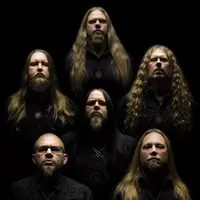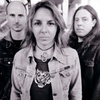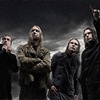Year of the Goat


Year of the Goat tour dates: 6 concerts in 2 countries
About Year of the Goat
Year of the Goat was established in the late 2000s as a Swedish occult rock band that is reminiscent of the dark psychedelia of the 1960s and 1970s but also carves out its own successful, riff‑driven trajectory. Led by engineer‑turned‑vocalist Trad Numen and supported by a revolving cast of musicians well‑versed in doom‑tinged riffery and pagan incantations, the band quickly generated a buzz in underground metal and rock communities. The band's sound is characterized by thick, riff‑laden songwriting, unearthly vocals, and an extreme interest in esoteric subject matter drawn from mythology, ritual, and alchemy. With a number of EPs, singles and two full‑length albums under their belt in over a decade, Year of the Goat has gained cult following among fans attracted to darker, mystical music in the genre of rock.
Early Formation and Origins
Year of the Goat started with Trad Numen's interest in old analog recording gear and the sound of early hard‑rock music. Convening in Gothenburg, Sweden, the group initially bonded over a common interest in occult aesthetics, old Marshall and Sunn amplifiers, and the appearance of early Black Sabbath and Blue Öyster Cult. Early live performances were making their reputation on Swedish underground stages, mixing ritualistic theatrics with heavy, catchy riffs that instantly distinguished them from more traditional doom bands.
The First EPs: Ritual Beginnings
Their initial documented efforts arrived in the form of self-released and underground label EPs that presented the group's raw, concentrated sound. With titles that reflected mystic dimensions and secret rituals, the releases debuted their flair for evocative, bass-driven rhythms topped with foreboding vocal pronouncements. Although restricted in distribution, these initial EPs built up momentum in underground circles that enabled them to open for more high‑profile bands when touring and to solidify their line‑up for a full‑length album.
Debut Full‑Length: "Pentagram Prayer"
The band's debut full‑length album, "Pentagram Prayer", received critical acclaim in underground media. The record presented a smooth integration of traditional heavy‑rock riffing, psychedelic texture, and lyrical subject matter that delved into occult rituals, witchcraft, and metaphysical longing. Tracks such as the title cut "Pentagram Prayer" and the anthem‑like "Witchphoric" showcased rich chord progressions, twin guitar leads, and Trad Numen's thick, chant‑like vocal approach. The album was commended for achieving both the retro ambiance complete with contemporary production lucidity and an infectious atmosphere of ritualistic drama.
Musical Style and Lyrical Themes
Year of the Goat's music is based on the early‑era doom rock but invigorated by hard‑rock forefathers' energy and melody consciousness. Hallmark features are mid‑ to up‑tempo riffs, twin‑guitar harmony, a keen focus on groove, and a vocal style that can veer from whispered intimacy to declarative triumph. Lyrical themes move across mythic symbolism, pagan ritual, and interpersonal allegory conveyed in ritual imagery. Alchemical transmutation, lunar cycles, and metaphysical conflict are common points of reference for the band, weaving a narrative at once intimate and cosmic.
Line‑Up Evolution and Collaborations
Although Trad Numen has been the constant figure at the heart of Year of the Goat, the line‑up has changed over the years, with guitarists, bassists and drummers being recruited from the Swedish underground rock scene. Some of the participants have introduced new direction—some tending towards psychedelic sound, others introducing more doom‑metal intensity. Side projects and guest spots have also seen them working with members of other Scandinavian occult‑rock bands, and remixes and reworkings of songs that explore metal, stoner‑rock and dark psych avenues.
Second Album: "Portrait of the Young Witch"
Year of the Goat came back with "Portrait of the Young Witch", an album extending their thematic range, after the success of their debut. Maintaining the trademark heaviness, this record added more complex arrangements and atmospheric interludes, with organ‑tinged passages and subdued orchestration placed within their trademark riff assaults. Songs like "Night Harvest" and "Temple of the Serpent" had a more open production with room for mood changes between ritualistic intensity and more contemplative moments.
Live Shows and Cult Status
Year of the Goat's live reputation has increased progressively, with performances at underground festivals and club headline shows throughout Europe. Live shows are above all an ambiance of ritual—darkened lights, suggestive backdrops, and focus on musicians' trance‑inducing interaction. Listeners tend to describe an immersive experience, as though having witnessed some dark ritual played out by pulsing guitar textures and mesmeric drumming. Word‑of‑mouth in occult‑rock circles has served to perpetuate their cult following and create momentum between album cycles.
Discovering the Occult Rock Revival
The early 2000s and 2010s witnessed a revival in interest in occult‑infused rock and doom, with bands directly borrowing from retro sources but infusing modern elements. Year of the Goat is firmly based within this revival, offering authenticity through their analog recording techniques, ritualistic lyrics, and adherence to classic song structures. Their direction is divergent from noiser or more modernized re interpretations, instead promoting clarity, melody, and the esoteric mysticism of early‑era heavy rock.
Artistic Vision and Recording Philosophy
At the heart of Year of the Goat's vision is their dedication to analog recording techniques. Studio sessions frequently feature vintage tape gear, tube preamps, and era‑style microphones in pursuit of warmth and presence. In so doing, they carry their ritualistic ethos from lyrical themes on through to sonic textures, closing the distance between past and present. Trad Numen has discussed in interviews the necessity of recording "the energy of the room", creating performances that are alive, organic, and ritualistically intense.
Recent Moves and New Material
In recent years, the band has been putting out singles, one-off collaborations and live sessions. They have tried remixing songs into more experimental forms, occasionally working with electronica or doom‑adjacent producers. This enables them to re-engage listeners between full releases, keep the mystique going, and offer hints of where they might be heading next. Live‑studio broadcasts and vinyl‑only singles have become the norm for building momentum.
Influence and Impact Within the Scene
Though never gaining mainstream commercial success, Year of the Goat has gained the respect of fellow musicians and loyal fans for their integrity and consistency in their craft. They have influenced newer European and Scandinavian bands wanting to combine heavy riffing and occult themes without compromising melody or songcraft. They have been referenced in underground publications as an example of how to distill classic alchemy into energetic contemporary rock.
There's been fan speculation of a third studio album, which could be delving into darker and more introspective subject matter or even drawing upon other mythologies outside European paganism. Sporadic social media teasers from the band indicate Trad Numen and co. are toying with new instrumental timbres, more epic song lengths and even narrative‑driven concepts that could take their sound to new levels. Whether it's through vinyl-only singles or surprise live performances, the band continues to build its mystique.
Amidst a backdrop full of occult and retro‑influenced groups, Year of the Goat tread a different path through their stubborn insistence on analogue authenticity, ritualistic live performances and hook‑laden songwriting. They offer a nexus between doom and classic hard rock, with riffs that are both timeless and timely. By doing this, they create for contemporary listeners an opening into the esoteric core of heavy rock, wherein atmosphere, melody and myth are inseparable.
Year of the Goat navigates a path through the netherworld of occult rock, presenting a fusion of ritual atmosphere, timeless rhythm and evocative lyrics. From the impassioned invocations of "Pentagram Prayer" to the more epic soundscapes of "Portrait of the Young Witch", the group has staked its place alongside those who pursue music as ritual and aural decadence. With a riff, they conjure an aura shimmering with mythic resonance and timeless intensity. As they write new chapters into their legend, fans eagerly anticipate the next invocation—a chance to step once again into their dark world, where riffs are rituals and music is magic.











